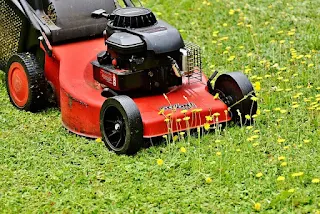Gas-powered leaf blowers and lawn mowers have long been popular tools for maintaining yards and gardens. However, mounting evidence suggests that these machines are shockingly bad for the planet, contributing to air and noise pollution, greenhouse gas emissions, and other negative environmental effects. As a result, bans on gas-powered leaf blowers and lawn mowers are beginning to spread across the country, with many cities and towns opting for more eco-friendly alternatives.
Where are Leaf Blowers banned?
As of now, California, Vermont, and Washington D.C. have banned or placed limits on gas powered lawn equipment. Several cities and states have similar legislation in the works. Seattle City Council is working to have gas powered leaf blowers banned in the city. Areas of New York have banned or limited Leaf Blowers
In this article, we'll explore the environmental impact of these machines and discuss the growing trend of bans and the shift towards greener options.
Why are Leaf Blowers Banned?
Tests performed by Edmunds' InsideLine.com, a leading hotbed of information for automotive enthusiasts, revealed that consumer-grade leaf blowers emit more pollutants than a heavy-duty 2011 Ford F-150 SVT Raptor. A Ryobi 4-stroke leaf blower produced almost seven times more nitrogen oxides (NOx) and 13.5 times more carbon monoxide (CO) than the Raptor. An Echo 2-stroke leaf blower performed even worse, generating 23 times more CO and nearly 300 times more non-methane hydrocarbons (NMHC) than the truck.
According to Jason Kavanagh, Engineering Editor at Edmunds.com, using a two-stroke leaf blower for half an hour of yard work emits the same amount of hydrocarbons as driving a Raptor for 3,900 miles from Texas to Alaska. Jokingly, Kavanagh suggests finding a way to use the Raptor for leaf blowing, as it would be more green and environmentally sound to do so.
In the same tests, a 2012 Fiat 500 emitted more hydrocarbons and NOx but less CO than the Raptor. Both the Raptor and Fiat 500 produced significantly fewer emissions than the leaf blowers. These results were obtained through FTP 75 emissions tests, a standard U.S. measure for light-duty vehicle emissions and fuel economy, conducted at the AAA Automotive Research Center in Diamond Bar, California.
The Environmental Toll of Gas-Powered Leaf Blowers and Lawn Mowers
Air Pollution
Gas-powered leaf blowers and lawn mowers are significant sources of air pollution due to their emissions of harmful pollutants, including volatile organic compounds (VOCs) and nitrogen oxides (NOx). When VOCs and NOx react with sunlight, they form ground-level ozone, a primary component of smog. Smog is a widespread environmental issue that affects air quality and contributes to various health problems.Ground-level ozone has been linked to several health risks, particularly in vulnerable populations such as children, the elderly, and individuals with pre-existing respiratory conditions. Exposure to elevated levels of ground-level ozone can lead to shortness of breath, chest pain, coughing, and throat irritation. It can also aggravate existing respiratory issues like asthma and bronchitis, increasing the frequency and severity of asthma attacks and other respiratory infections.
Moreover, long-term exposure to ground-level ozone may result in chronic respiratory diseases and reduced lung function. It can also affect the cardiovascular system, causing inflammation of the airways and increasing the risk of heart attacks and strokes. In addition, ground-level ozone has been associated with premature mortality due to its impact on respiratory and cardiovascular health.
Greenhouse Gas Emissions
Gas-powered lawn equipment, such as lawn mowers, leaf blowers, and trimmers, operate on fossil fuels, resulting in the release of carbon dioxide (CO2) and other greenhouse gases like methane (CH4) and nitrous oxide (N2O). These greenhouse gases are known to be major contributors to climate change due to their heat-trapping properties in the Earth's atmosphere.When fossil fuels combust within the engines of gas-powered lawn equipment, they undergo a chemical reaction that produces CO2 as a byproduct. This CO2 release is particularly significant, as it is the most prevalent greenhouse gas emitted by human activities. The molecular structure of CO2 allows it to absorb and re-emit infrared radiation, which prevents heat from escaping the Earth's atmosphere. This phenomenon, known as the greenhouse effect, leads to rising global temperatures, causing disruptions in ecosystems, changes in weather patterns, and the loss of polar ice.
Additionally, methane and nitrous oxide emissions, though less common, are more potent greenhouse gases than CO2. Methane has a global warming potential 28-36 times greater than CO2 over a 100-year period, while nitrous oxide's global warming potential is approximately 265-298 times greater than CO2 over the same timeframe. The presence of these gases in the atmosphere further exacerbates the impact of gas-powered lawn equipment on climate change.
According to a swedish study , a single gas-powered lawn mower can produce as much greenhouse gas emissions in an hour as driving a car for 100 miles.
Noise Pollution
Gas-powered leaf blowers and other lawn equipment produce significant noise pollution, which can have a range of adverse effects on human health and well-being. These machines can generate noise levels up to 100 decibels (dB), which is comparable to the sound intensity of a motorcycle or a live rock concert. Prolonged exposure to such loud noise can result in hearing damage, as the delicate structures within the human ear can be permanently affected.Aside from hearing damage, constant exposure to noise pollution from gas-powered lawn equipment can lead to various negative impacts on mental health and overall quality of life. High noise levels can cause increased stress, anxiety, and irritability. This is particularly true for individuals who are sensitive to noise or who are already experiencing stress from other sources. In some cases, noise pollution has been linked to sleep disturbances, which can further exacerbate mental health issues and contribute to chronic fatigue.
Noise pollution also affects the community as a whole. The loud sounds generated by gas-powered leaf blowers and other equipment can disturb nearby residents, interfering with their daily activities and reducing their overall enjoyment of their homes and neighborhoods. This can lead to increased tension between neighbors and a decline in the sense of community.
Moreover, noise pollution is not limited to impacting human health and well-being; it can also have negative consequences for wildlife. Many animal species rely on sound for communication, navigation, and detecting predators or prey. The loud noise generated by gas-powered lawn equipment can interfere with these essential functions, disrupting the natural behavior of animals and potentially affecting their survival and reproduction.
Soil and Water Contamination
Gas-powered lawn equipment, such as lawn mowers and leaf blowers, utilize fossil fuels and other chemicals, including oil and lubricants, to function effectively. Accidental spills, leaks, and improper disposal of these substances can lead to soil and water contamination, which poses threats to human health and local ecosystems.
When fuel, oil, or other chemicals seep into the ground, they can contaminate soil, making it unsuitable for plant growth and potentially affecting the stability of local ecosystems. Contaminated soil may also release harmful vapors, which can pose inhalation risks to humans and wildlife. In addition, some chemical components can be absorbed by plants, potentially entering the food chain and affecting the health of herbivores and their predators.
Water contamination occurs when spilled fuel, oil, or chemicals enter groundwater, surface water, or runoff, affecting the quality of water sources such as rivers, lakes, and reservoirs. This can have detrimental consequences for aquatic ecosystems, as the toxic substances can harm or kill fish, plants, and other organisms that inhabit these water bodies. Moreover, contaminated water can indirectly impact terrestrial ecosystems, as it may be consumed by animals and plants that rely on these water sources.
Human health can also be affected by contaminated water, particularly if the pollutants find their way into drinking water supplies. Ingesting contaminated water can lead to a variety of health issues, ranging from mild symptoms such as nausea and skin irritation to more severe conditions like liver and kidney damage or even cancer, depending on the type and concentration of the pollutants.
Gas Powered Lawn Equipment Alternatives
There are several alternatives to traditional gas-powered lawn equipment. These alternatives focus on reducing environmental impact and fostering eco-friendly landscaping practices:Manual tools
Electric and battery-powered equipment
Electric and battery-powered lawn equipment serves as a viable alternative to traditional gas-powered machines, offering numerous benefits in terms of energy efficiency and environmental impact. These options include electric or battery-powered lawn mowers, leaf blowers, hedge trimmers, and string trimmers, which can effectively perform the same tasks as their gas-powered counterparts while minimizing emissions and noise pollution.- Energy efficiency: Electric and battery-powered lawn
equipment typically uses less energy compared to gas-powered equipment.
They convert a higher percentage of the energy they consume into actual
work, reducing energy waste. Additionally, they do not require fossil
fuels, which helps conserve non-renewable resources.
- Lower
emissions: Unlike gas-powered equipment, electric and battery-powered
options do not produce harmful exhaust emissions, such as carbon dioxide
(CO2), volatile organic compounds (VOCs), and nitrogen oxides (NOx). As
a result, they contribute less to air pollution and greenhouse gas
emissions, mitigating their impact on climate change and public health.
- Reduced
noise pollution: Electric and battery-powered lawn equipment generally
operates more quietly than gas-powered machines, resulting in less noise
pollution. This can improve the overall quality of life for users and
those living nearby by reducing disturbances and potential hearing
damage.
- Ease of maintenance: Electric and battery-powered equipment usually requires less maintenance compared to gas-powered machines. There are no spark plugs, oil changes, or fuel filters to deal with, making their upkeep simpler and more cost-effective.





No comments:
Post a Comment